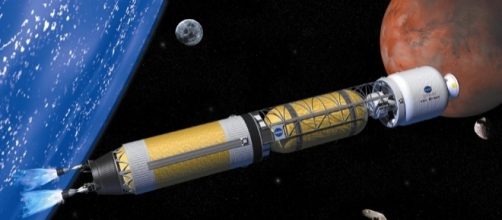Last month, NASA quietly gave an $18.8 million contract to BWXT Nuclear Energy Inc. of Virginia to study advanced fuel designs for nuclear rockets. It's about time. Nuclear rockets have been waiting on the sidelines of spaceflight since even before 1957, when the Russians lofted the first artificial satellite, Sputnik 1, into orbit.
Nuclear Rockets have been around for quite awhile
Back in the 1960s and 1970s, the USA actually had a nuclear rocket program called NERVA (Nuclear Engine for Rocket Vehicle Application). If NERVAs had ever flown, they would have been launched into orbit atop the massive Saturn V moon rocket, and humans might have reached Mars as early as 1982.
But NASA's Mars plans died with the end of Project Apollo, and a cost-cutting US Congress canceled the nearly completed NERVA in 1973.
Interest in nuclear drives never entirely died away, however. In 2000, NASA launched Project Prometheus. Prometheus proposed using a nuclear-powered ion drive rocket to send the JIMO (Jupiter Icy Moons Orbiter) to investigate the giant planet's four largest moons Ganymede, Callisto, Io, and Europa. Most space scientists believe Europa conceals an ocean of liquid water beneath its many kilometers thick ice cap. A nuclear-propelled JIMO could have reached Jupiter carrying a much larger and more capable scientific payload than its chemically fuelled counterparts.
Budget constraints killed Prometheus in 2005.
The Advantages of Nuclear Propulsion
Merely hearing the names Chernobyl and Fukushima still makes many people cringe, so why nuclear rockets?
Speed and payload are the primary arguments for nuclear rockets. The old NERVA could have taken astronauts to Mars in four months as opposed to six months for chemical drives, drastically cutting radiation exposure while alleviating the cardiovascular problems, the loss of bone density, and the muscle shrinkage associated with prolonged weightlessness.
Using nuclear fission, nuclear rockets burn their fuel hotter and more efficiently than chemical rockets. This translates into lower fuel consumption, reduced weight and increased payload, all critical issues for ventures beyond Earth orbit.
Barring fusion, the ultimate nuclear rocket design may be VASIMIR (Variable Specific Impulse Magnetoplasma Rocket).
Developed by physicist and ex-astronaut Dr. Franklin Chang Diaz, VASIMIR uses powerful radio waves to ionize its fuel and then spit it out in a high temperature, high-velocity stream. Ion drives like VASIMIR are slow starters, but can eventually reach very high speeds, and a nuclear VASIMIR could reach Mars in six weeks. NASA and Dr. Diaz plan extensive ground testing of VASIMIR next year.
Safety Concerns are easily addressed
Nuclear rockets should be able to satisfy most people's safety concerns. First, the rocket's reactor doesn't go critical until reaches orbit. Up until then the reactor's highly enriched uranium (the BWTX design uses only 20% HEU, so an explosion is impossible) is relatively inert.
Second, unlike the hundreds of tons of uranium that fuel commercial power reactors, nuclear rockets use only very small amounts of HEU. Finally, once a nuclear rocket reaches the end of its useful life, it can be launched into the depths of space using an attached booster rocket.
Nuclear drives would allow easy access to the Solar Systems's vast resources. Lacking nuclear rockets, humanity will be confined to the Earth-Moon system and dangerous slow boat voyages to Mars.


